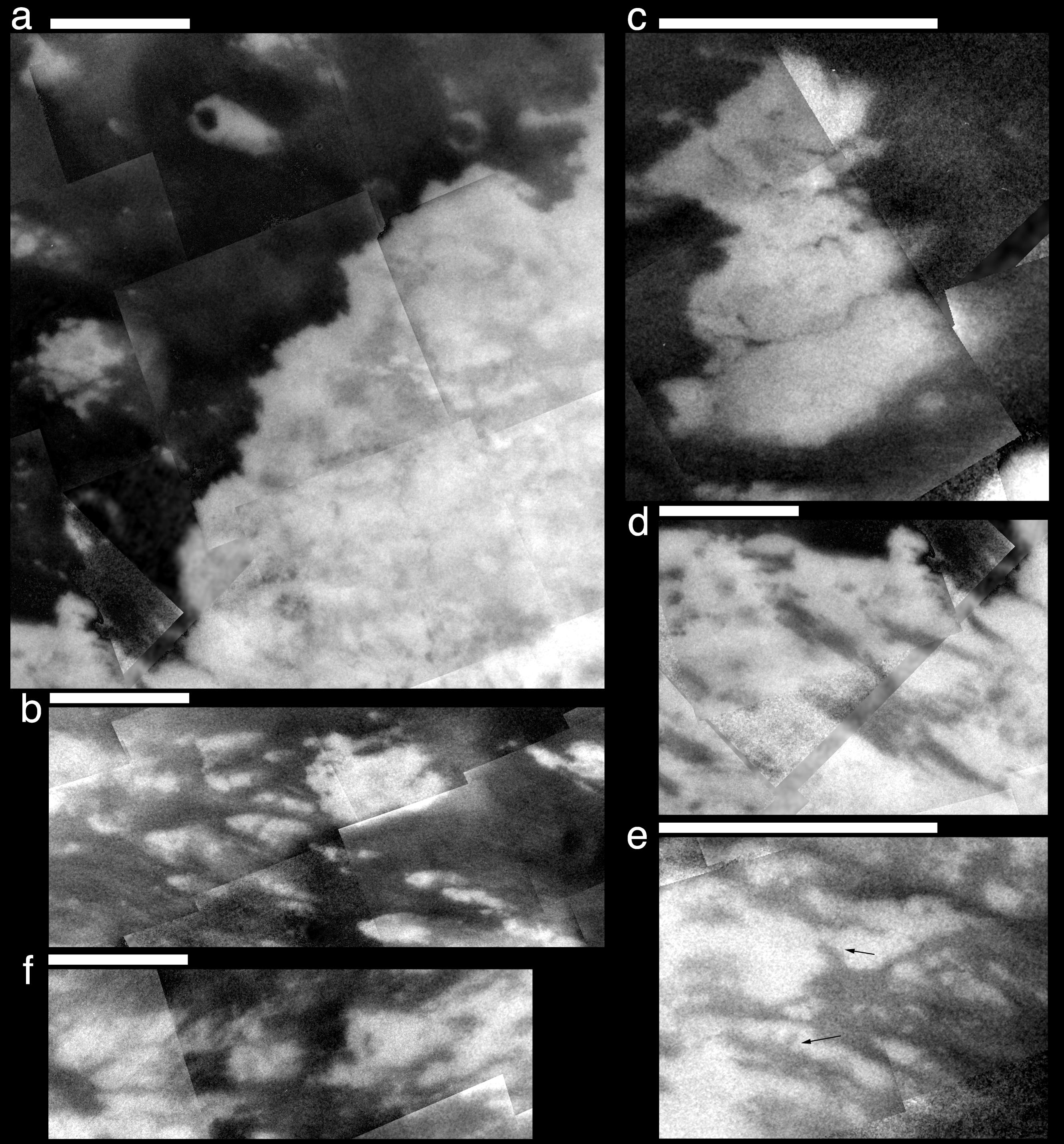Scrutinizing Titan’s Surface

| PIA Number | PIA06204 |
|---|---|
| Language |
|
The six close-up views of Titan's surface shown here are composed of images acquired by the Cassini spacecraft during flybys in October (see Titan Mosaic: October 2004) and December (see Titan Mosaic: December 2004) of 2004. These close-up views illustrate that a variety of processes have shaped the surface of Titan, just as diverse geologic processes are responsible for what we see on Earth's surface.
Image (a) shows a prominent bright-dark boundary near the western edge of the Xanadu region which exhibits a sharp, angular edge between the materials. Three bright, discontinuous circles can be seen (two near the top of the image and another near the lower left). These may be large impact craters; the upper two are approximately 30 kilometers (18.6 miles) in diameter and the lower one is approximately 50 kilometers (20 miles) in diameter. Titan's thick atmosphere will screen out small projectiles, but if the surface were as old as Titan itself, it should have many more craters of these sizes. Therefore, Cassini scientists think that, like Earth's surface, Titan's surface has been modified more recently by other geologic processes. However, such processes on Titan may take much longer than on Earth, acting over hundreds of millions of years.
Image (b) shows bright features that appear to be streamlined as if were they formed by winds in Titan's atmosphere moving from west to east. The landing site of the Huygens probe is in the upper left corner of this image (see Cassini's View of Titan Landing Site).
Image (c) shows a bright feature surrounded by dark material. Several long, dark and narrow lines running through the bright area may be larger examples of the dark channels seen by the Huygens probe (see Mosaic of River Channel and Ridge Area on Titan). These lines are on the order of 2 kilometers (1 mile) wide, and tens of kilometers long.
Image (d) shows dark material within the bright area to the west of Xanadu. The linear nature of these features suggests that they may have formed by faulting. They may be dark due to modification by other surface processes occurring on Titan, in the same way that on Earth, fault-lines can be enhanced by erosion and/or deposition of material by water and wind.
Image (e) shows brightness variations in the region southeast of the Huygens landing site. The features indicated by arrows exhibit shapes that are similar to drainage patterns seen on Earth and Mars, where the source of the liquid is underground springs rather than rainfall.
Image (f) shows a region near the northwestern edge of Xanadu where the boundary between the bright and dark materials is quite complicated. Here some of the bright patches appear as if they represent thin surface plates that have been broken apart and spread apart over underlying dark material.
The white bars above each image are 200 kilometers (124 miles) long. Imaging Titan through its thick atmosphere is a challenge, and the narrow, straight lines within the images are seams between individual images that have not been completely removed. North is to the top of each frame.
The Cassini-Huygens mission is a cooperative project of NASA, the European Space Agency and the Italian Space Agency. The Jet Propulsion Laboratory, a division of the California Institute of Technology in Pasadena, manages the mission for NASA's Science Mission Directorate, Washington, D.C. The Cassini orbiter and its two onboard cameras were designed, developed and assembled at JPL. The imaging team is based at the Space Science Institute, Boulder, Colo.
For more information about the Cassini-Huygens mission visit http://saturn.jpl.nasa.gov . For additional images visit the Cassini imaging team homepage http://ciclops.org .
Credit: NASA/JPL/Space Science Institute.
